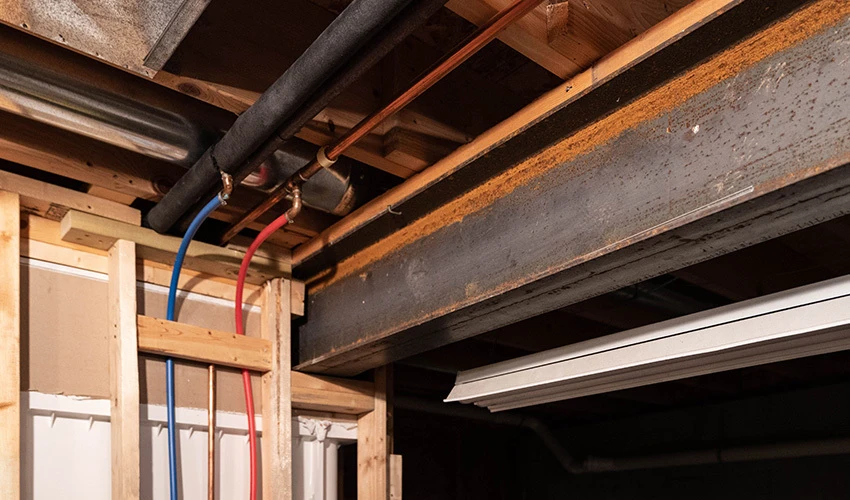
Mr. Handyman explains how to identify load-bearing walls in your home.
|
Before taking on any home renovations that are designed to create an open floor plan or add more space, you need to understand whether a wall is cosmetic or load-bearing. Don’t attempt to remove any wall until you know how it functions in relation to the structural integrity of your home. If the wall you are considering removing is a load-bearing wall, you may want to change your renovation plans. Here’s why.
What is a Load Bearing Wall?
A load-bearing wall helps support the weight of certain features of your home. It could be your roof, ceiling, floors, or other structural components. These walls are responsible for holding up the floors above them, and in some cases, the roof of the structure. Sometimes called “bearing walls,” they are designed to transfer weight from the top of the house to the foundation.
Demolishing a load-bearing wall could quickly impact the safety of your home, as removing it threatens the structural integrity of your home. Making sure the wall you plan to remove isn’t load-bearing is incredibly important.
But how can you tell which walls in your home are load-bearing? This guide will help you identify a load-bearing wall so you can make an appropriate plan. However, it’s not recommended to remove any wall without consulting with an expert.
How to Determine a Load-Bearing Wall
When making renovations to your home, it’s important to avoid tearing down load-bearing walls. Here is a checklist to tell if the wall you want to take down is load-bearing:
- Grab the blueprints — A great place to start is by digging out the original blueprints if they’re available. The original blueprints for the home will tell you which walls are load-bearing and which ones are not. If a wall is marked as “S” in the blueprint, this means “structural,” thus showing it’s a load-bearing wall.
- Check your ceiling — Take a look at your ceiling to identify any load-bearing beams that run across the house. Any walls beneath these beams are probably also load-bearing. If you can’t identify a load-bearing beam below the wall, it’s most likely not supporting any weight. However, it’s always best to confirm via the blueprints or get an expert's opinion.
- Assess your basement — Look in your basement or crawl space for steel beams or joists. If you spot joists in your basement and there is a wall that runs perpendicular, it's most likely a load-bearing wall. If the wall is parallel above the joists, it’s most likely not a load-bearing wall.
- Check the foundation — If a wall or beam is directly connected to the foundation of your house, it is a load-bearing wall. This is particularly true for homes with additions, since walls that are interior now may have originally been exterior walls. Checking your home’s original blueprint can help with this.
Load-Bearing Wall Removal Facts
You can remove a load-bearing wall, but you should never do it without consulting a professional builder or engineer. They will know how to tell if a wall is load-bearing or not.
If you remove a load-bearing wall without the proper planning, it could quickly lead to disaster in the form of structural instability, ceiling sagging, or worse, collapse.
How to determine a load-bearing wall is important, but there are other factors that also need to be considered. For example:
- A permit could be required — Some city ordinances require a permit and a structural engineer's sign-off if walls are being replaced or torn down.
- Replacement support is mandatory — Structural support must be in place before removing the wall. It’s necessary to have a plan in place; otherwise, your home will start to sag over time.
- Know your beams — For this type of project, a heavy-duty beam is needed if you are looking to fully remove a load-bearing wall. By purchasing and installing an LVL (laminated veneer lumber) support beam, you can ensure the stability of your home’s structure – you simply can’t rely on anything smaller to support your roof properly.
- Removal is dangerous — Removing load-bearing walls can be a difficult and dangerous task. When deciding to remove one, it is necessary to take the proper safety precautions at all times. Never complete this task on your own. Always call an expert who knows how to tell if a wall is load-bearing and how to remove it. This will help you avoid disaster.
Alternatives To Removing A Load-Bearing Wall
Sometimes, the cost and labor involved in removing a load-bearing wall are more than a homeowner planned for originally. At this point, exploring alternatives to removing a load-bearing wall may prove to be the best option.
Pass-thru openings allow homeowners to keep load-bearing walls intact while helping achieve the desired open floor plan functionality. It is also a less expensive option than removal, easier to install, and often doesn't require extra costs in the way of permits or engineers.
Trust the Experts at Mr. Handyman
If you are ready to make renovations to your home, the team of licensed contractors and experts at your local Mr. Handyman will ensure your project gets completed safely and in accordance with all specifications.
How to determine a load-bearing wall is not always an exact science. Therefore, in some cases, we may call in an engineer to assess the project and to determine if other options, such as a pass-thru opening, are a better solution.
Ready to get started creating your open floor plan or remodel? Trust your local professionals at Mr. Handyman to help turn your dream renovation into a reality.
Schedule an appointment online to get started today.
This article is intended for general guidance only and is not applicable to every situation. You are responsible for determining the proper course of action for your property and situation. Mr. Handyman is not responsible for any damages that occur as a result of advice and/or guidance derived from its blog content. Some Mr. Handyman services vary by location. Contact your local Mr. Handyman franchise for more information.
FAQs About Load-Bearing Walls
Mr. Handyman has been helping homeowners repair, maintain, and enhance their spaces for over 25 years! We are the one-stop solution for everything on your to-do list. This includes answering your questions about home repairs, maintenance, and improvements. Here are answers to some of your most frequently asked questions on how to determine if a wall is load-bearing.
Are all exterior walls load-bearing?
In most homes, yes. Exterior walls usually support the roof and upper floors, transferring structural loads down to the foundation. If you're wondering how to tell if a wall is load-bearing, exterior walls are a safe bet, but modern framing can occasionally shift support elsewhere. Check your home blueprints and any additional structural plans to confirm whether an exterior wall is load-bearing.
Is a wall load-bearing if it runs parallel to floor joists?
While walls that run perpendicular to floor joists are commonly load-bearing, a wall running parallel can also bear loads, especially if it aligns directly under a single joist or if there's additional structural support like blocking between joists. Therefore, it's not solely the orientation but also the specific structural context that determines if a wall is load-bearing.
How to identify load-bearing walls without removing drywall?
You can often identify load-bearing walls without cutting into them by examining a few key structural clues:
- Check joist direction: If the wall runs perpendicular to floor or ceiling joists, it’s likely load-bearing.
- Look in the attic or basement: Load-bearing walls usually have beams, posts, or other structural elements directly beneath or above them.
- Measure the wall thickness: Walls thicker than 4.5 to 6 inches are more likely to be structural.
- Note the location: Central interior walls and all exterior walls are typically load-bearing.
- Review blueprints: Original framing plans often label structural walls.
These non-invasive checks can help, but when safety’s on the line, it’s always best to get a professional assessment.
How much of a load-bearing wall can be removed?
You can remove part or all of a load-bearing wall, but it requires precise structural planning. To do it safely, the weight the wall was carrying must be transferred to another structural element, such as a support beam or vertical post.
Key considerations include:
- The size of the opening you want to create
- How much weight the wall is carrying (roof, upper floors, etc.)
- Structural support requirements, like LVL beams or steel posts
- Local building codes and permit requirements
Structural integrity isn’t a guessing game, and even removing just a few feet of a load-bearing wall can impact your home’s stability. That’s why it’s critical to consult a structural engineer or experienced contractor to assess the load and design a proper support system before making any structural alterations. If you’re unsure how to tell if a wall is load-bearing or how much you can safely remove, call in the pros.
What are the risks of removing a load-bearing wall?
Removing a load-bearing wall without the proper precautions can compromise a building's structural integrity, leading to potential sagging or collapse. To safely remove a load-bearing wall, it's essential to install the appropriate support systems, like beams or columns, to redistribute the weight and load. This process is delicate and should be designed and executed by qualified professionals to guarantee safety and compliance with building codes.
What is the cost to remove a load-bearing wall?
Costs vary based on your home’s size, wall length, and complexity of the project. In general:
- Single-story homes: $1,200–$3,000
- Multi-story homes: $3,000–$10,000+
- Additional costs: Rerouting electrical, plumbing, or HVAC will increase the cost
For an accurate estimate, consult with a licensed contractor familiar with how to determine if a wall is load-bearing and how to remove it safely.
Do you need a permit to tear down a load-bearing wall?
Yes. Since removing a structural wall affects your home’s integrity, most cities and municipalities require a building permit. You may also need:
- Engineering plans
- Structural load calculations
- Post-removal inspections
Failing to obtain a permit can lead to code violations and unsafe results.
Do I need a professional to remove a load-bearing wall?
Knowing how to identify load-bearing walls is about more than structure—you’ll need the expertise of someone familiar with the invisible systems that keep your home safe and sound. Removing a load-bearing wall isn’t just about knocking down drywall; it’s a complex process that requires an understanding of the architecture that holds your home together.
At Mr. Handyman, we believe your home should support your life—literally and figuratively. That’s why our service professionals bring an average of 10 years of experience in the trades, arriving on time and equipped with the tools and insight to get the job done right.
Let us handle the heavy lifting. Find your local Mr. Handyman today.
